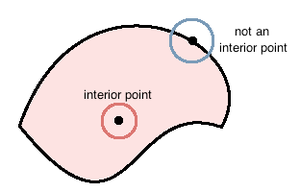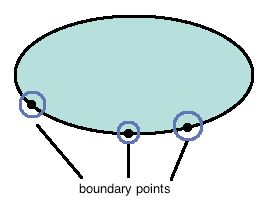Difference between revisions of "The Topology of Higher Dimensions: interior, closure and boundary"
(Created page with "We are now going to discuss some important classifications of points regarding a subset <span class="math-inline"><math>S</math></span> of <span class="math-inline"><math>\mat...") |
|||
| Line 1: | Line 1: | ||
We are now going to discuss some important classifications of points regarding a subset <span class="math-inline"><math>S</math></span> of <span class="math-inline"><math>\mathbb{R}^n</math></span> which we define below.</p> | We are now going to discuss some important classifications of points regarding a subset <span class="math-inline"><math>S</math></span> of <span class="math-inline"><math>\mathbb{R}^n</math></span> which we define below.</p> | ||
<blockquote style="background: white; border: 1px solid black; padding: 1em;"> | <blockquote style="background: white; border: 1px solid black; padding: 1em;"> | ||
| − | <td><strong>Definition:</strong> Let <span class="math-inline"><math>S \subseteq \mathbb{R}^n</math></span>. A point <span class="math-inline"><math>\mathbf{a} \in \mathbb{R}^n</math></span> is said to be an <strong>Interior Point</strong> of <span class="math-inline"><math>S</math></span> if there exists an <span class="math-inline"><math>r | + | <td><strong>Definition:</strong> Let <span class="math-inline"><math>S \subseteq \mathbb{R}^n</math></span>. A point <span class="math-inline"><math>\mathbf{a} \in \mathbb{R}^n</math></span> is said to be an <strong>Interior Point</strong> of <span class="math-inline"><math>S</math></span> if there exists an <span class="math-inline"><math>r > 0</math></span> such that <span class="math-inline"><math>B(\mathbf{a}, r) \subseteq S</math></span>, i.e., there exists an open ball centered at <span class="math-inline"><math>\mathbf{a}</math></span> for some positive radius <span class="math-inline"><math>r</math></span> that is a subset of <span class="math-inline"><math>S</math></span>. The set of all interior points of <span class="math-inline"><math>S</math></span> is denoted by <span class="math-inline"><math>\mathrm{int} (S)</math></span>.</td> |
</blockquote> | </blockquote> | ||
| − | <p>In the case where <span class="math-inline"><math>n = 2</math></span> and we have some subset <span class="math-inline"><math>S \subseteq \mathbb{R}^2</math></span> (like the one illustrated below), then we say that a point <span class="math-inline"><math>\mathbf{a} \in \mathbb{R}^2</math></span> is an interior point if there exists an open disk of some positive radius <span class="math-inline"><math>r | + | <p>In the case where <span class="math-inline"><math>n = 2</math></span> and we have some subset <span class="math-inline"><math>S \subseteq \mathbb{R}^2</math></span> (like the one illustrated below), then we say that a point <span class="math-inline"><math>\mathbf{a} \in \mathbb{R}^2</math></span> is an interior point if there exists an open disk of some positive radius <span class="math-inline"><math>r > 0</math></span> that is entirely contained in <span class="math-inline"><math>S</math></span>.</p> |
| − | + | ||
| + | [[File:Interior point.png|thumb|Interior point]] | ||
| + | |||
<p>In the illustration above, we see that the point on the boundary of this subset is not an interior point. If we take a disk centered at this point of ANY positive radius then there will exist points in this disk that are always not contained within the pink region.</p> | <p>In the illustration above, we see that the point on the boundary of this subset is not an interior point. If we take a disk centered at this point of ANY positive radius then there will exist points in this disk that are always not contained within the pink region.</p> | ||
<blockquote style="background: white; border: 1px solid black; padding: 1em;"> | <blockquote style="background: white; border: 1px solid black; padding: 1em;"> | ||
| − | <td><strong>Definition:</strong> Let <span class="math-inline"><math>S \subseteq \mathbb{R}^n</math></span>. A point <span class="math-inline"><math>\mathbf{a} \in \mathbb{R}^n</math></span> is said to be a <strong>Boundary Point</strong> of <span class="math-inline"><math>S</math></span> if for every for every <span class="math-inline"><math>B(\mathbf{a}, r)</math></span> with <span class="math-inline"><math>r | + | <td><strong>Definition:</strong> Let <span class="math-inline"><math>S \subseteq \mathbb{R}^n</math></span>. A point <span class="math-inline"><math>\mathbf{a} \in \mathbb{R}^n</math></span> is said to be a <strong>Boundary Point</strong> of <span class="math-inline"><math>S</math></span> if for every for every <span class="math-inline"><math>B(\mathbf{a}, r)</math></span> with <span class="math-inline"><math>r > 0</math></span> there exists <span class="math-inline"><math>\mathbf{x}, \mathbf{y} \in B(\mathbf{a}, r)</math></span> such that <span class="math-inline"><math>\mathbf{x} \in S</math></span> and <span class="math-inline"><math>\mathbf{y} \in S^c</math></span>, i.e., in every ball centered at <span class="math-inline"><math>\mathbf{a}</math></span> there exists a point contained in <span class="math-inline"><math>S</math></span> and a point contained in the complement <span class="math-inline"><math>S^c</math></span>. The set of all boundary points of <span class="math-inline"><math>S</math></span> is denoted <span class="math-inline"><math>\mathrm{bdry} (S)</math></span>.</td> |
</blockquote> | </blockquote> | ||
<p>For <span class="math-inline"><math>n = 1</math></span>, <span class="math-inline"><math>\mathrm{bdry} (S)</math></span> comprises the endpoints of <span class="math-inline"><math>S</math></span>. For <span class="math-inline"><math>n = 2</math></span>, <span class="math-inline"><math>\mathrm{bdry} (S)</math></span> comprises the border of <span class="math-inline"><math>S</math></span> as illustrated below:</p> | <p>For <span class="math-inline"><math>n = 1</math></span>, <span class="math-inline"><math>\mathrm{bdry} (S)</math></span> comprises the endpoints of <span class="math-inline"><math>S</math></span>. For <span class="math-inline"><math>n = 2</math></span>, <span class="math-inline"><math>\mathrm{bdry} (S)</math></span> comprises the border of <span class="math-inline"><math>S</math></span> as illustrated below:</p> | ||
| − | + | ||
| + | [[File:Boundary points.png|thumb|Boundary points]] | ||
| + | |||
<p>For <span class="math-inline"><math>n = 3</math></span>, <span class="math-inline"><math>\mathrm{bdry} (S)</math></span> comprises the surface of <span class="math-inline"><math>S</math></span>.</p> | <p>For <span class="math-inline"><math>n = 3</math></span>, <span class="math-inline"><math>\mathrm{bdry} (S)</math></span> comprises the surface of <span class="math-inline"><math>S</math></span>.</p> | ||
<blockquote style="background: white; border: 1px solid black; padding: 1em;"> | <blockquote style="background: white; border: 1px solid black; padding: 1em;"> | ||
| Line 16: | Line 20: | ||
</blockquote> | </blockquote> | ||
<p>For <span class="math-inline"><math>n = 2</math></span>, a visualization of some exterior points of a set of points (in green) is illustrated below:</p> | <p>For <span class="math-inline"><math>n = 2</math></span>, a visualization of some exterior points of a set of points (in green) is illustrated below:</p> | ||
| − | + | ||
| + | [[File:Exterior points.png|thumb|Exterior points]] | ||
Revision as of 14:27, 9 November 2021
We are now going to discuss some important classifications of points regarding a subset of which we define below.
Definition: Let . A point is said to be an Interior Point of if there exists an such that , i.e., there exists an open ball centered at for some positive radius that is a subset of . The set of all interior points of is denoted by .
In the case where and we have some subset (like the one illustrated below), then we say that a point is an interior point if there exists an open disk of some positive radius that is entirely contained in .
In the illustration above, we see that the point on the boundary of this subset is not an interior point. If we take a disk centered at this point of ANY positive radius then there will exist points in this disk that are always not contained within the pink region.
Definition: Let . A point is said to be a Boundary Point of if for every for every with there exists such that and , i.e., in every ball centered at there exists a point contained in and a point contained in the complement . The set of all boundary points of is denoted .
For , comprises the endpoints of . For , comprises the border of as illustrated below:
For , comprises the surface of .
Definition: Let . A point is said to be an Exterior Point of if . The set of all exterior points of is denoted .
For , a visualization of some exterior points of a set of points (in green) is illustrated below:
























